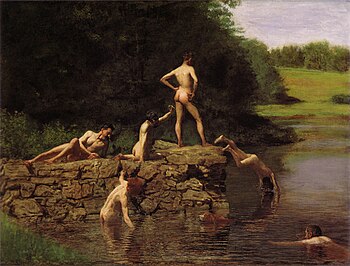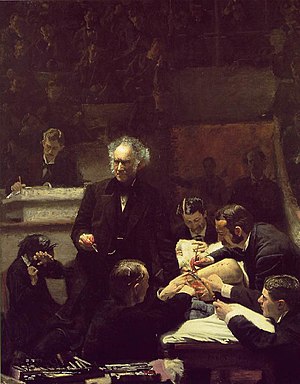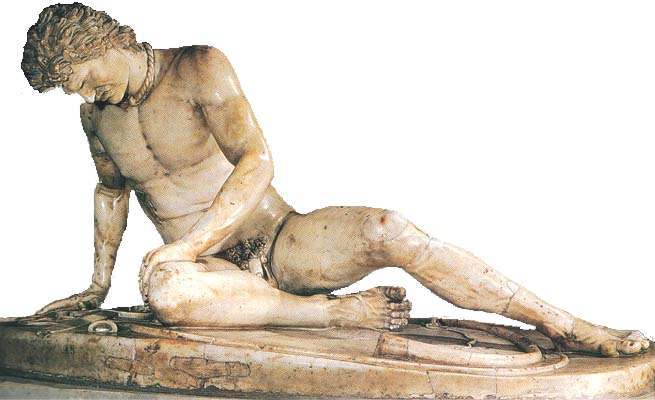When we look at American paintings, we hardly see what is uniquely American and what focuses on gender issues. Regionalism was a movement that brought about art that was uniquely American. This movement portrayed the life style of the mid-west, and through this portrayal American painters provoked many questions regarding gender. Thomas Eakins and Mary Cassatt are two American painters that focused on specific gender roles, this allowed us to see male and female views in a different perspective; one that is considered modern. When we examine the works of these two artists, we cannot undermine gender issues by looking at masculinity and femininity, but by looking at the social conditions that both artists portray in their subject matter. Eakins and Cassatt rejected the norm of painting pretty or glamorous portraits of women, but painted them in an innocent, true to life, and unglamorous way. Impressionism allowed both artists to reject the formal aspect of depicting the reality of things, but rather to portray their own sense of gender which was important in their paintings.
Gender plays an important role, whether consciously or subconsciously. Cassatt and Eakins redefined the roles for both men and women. In the midst of impressionism, Mary Cassatt used an impressionistic quality of capturing the fleeting moment; the intense light quality, feather like impressions of the brush stroke, the intimacy of
portraiture, and the flatness of the surface. Cassatt's, The First Caress, 1890, captures the light filled room that shows the moment of motherhood. Here we see a more intimate, private scene of mother and child; a kind of delicate and innocent moment. Cassatt is able to capture an intimate encounter between mother and child. This subject matter empowers women, and shows the devotional, and dedicational strength of motherhood. Rather than seeing motherhood as a task, Cassatt makes it seem like a ritual, a kind of intimacy that is only privileged to women.

Unlike the intimate, private depiction of motherhood in Cassatts painting, Thomas Eakins depicts the subject of male heroism. For example, The Swimming Hole, 1883, depicts a scene where nude males gather to swim and enjoy nature in a very public manner, unlike the intimacy in Cassatt's painting. Eakins shows elements of a realist painter when rendering the male figure in classical proportions and modeled after the Greek contropposto pose of Dying Gaul. The male in the middle of the painting also stands in a classical contrapposto pose. Attention to detail is highly regarded in his painting. We also get a sense that Eakins paints the male nude to elevate them to the classical heroic and idealized ideas of the Greek and Romans. We can also see elements of impressionist painting, for example the intensity of the light filling the image, but also capturing refracted light on the water and the sky. We can also see Eakins attention to nature, and his glorification of the scenes depicting American freedom. As an American painter in Paris, he did not forget his roots, and his undying love for the American landscape. This is evident in the traditional painting ways that other American painters before Eakins adopted, such as Thomas Cole.
 The invention of the
camera takes photography to the height of art, yet traditional art like
painting still remains the top contender as well. There is less
attention to the realism of the painting, and artists move to a new,
more exciting movement of impressionism to capture the essence of image
rather than depicting what is reality. Marry Cassatt use it to her
advantage. She painted portrait of women that were both powerful, yet
sensual which defied the normal roles expected of women. Cassatt's
The invention of the
camera takes photography to the height of art, yet traditional art like
painting still remains the top contender as well. There is less
attention to the realism of the painting, and artists move to a new,
more exciting movement of impressionism to capture the essence of image
rather than depicting what is reality. Marry Cassatt use it to her
advantage. She painted portrait of women that were both powerful, yet
sensual which defied the normal roles expected of women. Cassatt'spainting, Woman in Black at the Opera, 1880 acknowledged the male gaze which male artists painted in female nude as an object for male spectators; a man is staring at woman in the back. Cassatt's portrays a woman in the eye of the public, but Cassatt also rejects the gaze by using binoculars to look into the opera. It is quite scandalous for a female artist to paint woman in such power, the power of the oppositional gaze. Cassatt not only captures the impression of the woman in black but she is gives the spectator a different view on gender roles, especially of the high class. The woman in black is not a woman of lower class but a woman of the upper class who is in total control of her position and power. Although the subject is a public event, it still retains a sense of privacy like most of Cassatts paintings.
 Back
home in America, Eakins produced portraits that speak on the heroism of
democratic America. His subjects are still predominantly male figures.
In The Gross Clinic, 1875, Eakins takes the subject of operation to a
grander scale. He is patronizing the practice of good health and
medical advance in America. The main figure in the picture plane is a
doctor, a prominent figure in field of surgery. As a realist painter,
Eakins also depict the scene is a more detail way with dramatic
lighting. It is to capture the moment, a moment in time of the
operation. Although it is vividly cruel some yet it is quite modern in
it subject matter. The subject here is no longer the dissect corpse but
instead a life saving moment. Eakins shows only male as it is a male
dominant field and the male protagonist is showing his fellow students
how to operate. We see the intensity in the color and the use of light.
Altogether, we see Eakins interest in the male figure as his dominate
picture plane.
Back
home in America, Eakins produced portraits that speak on the heroism of
democratic America. His subjects are still predominantly male figures.
In The Gross Clinic, 1875, Eakins takes the subject of operation to a
grander scale. He is patronizing the practice of good health and
medical advance in America. The main figure in the picture plane is a
doctor, a prominent figure in field of surgery. As a realist painter,
Eakins also depict the scene is a more detail way with dramatic
lighting. It is to capture the moment, a moment in time of the
operation. Although it is vividly cruel some yet it is quite modern in
it subject matter. The subject here is no longer the dissect corpse but
instead a life saving moment. Eakins shows only male as it is a male
dominant field and the male protagonist is showing his fellow students
how to operate. We see the intensity in the color and the use of light.
Altogether, we see Eakins interest in the male figure as his dominate
picture plane.We see the two different painting style yet they both giving a new and modern in their subject matter. One is quite intimate and private as to portray the life of the upper class especially strong and powerful woman figure. The other is strong in the present of public figure and elevates the figure to a heroic figure. The gender role portray by each artist is subtle yet they are loud. As American painter, they both has open up a conversation of gender different that inscribed in their painting.
Works cited
Eisenman, Stephen, and Thomas E. Crow. Nineteenth Century Art: A Critical History. New York: Thames & Hudson, 2011. Print.


No comments:
Post a Comment